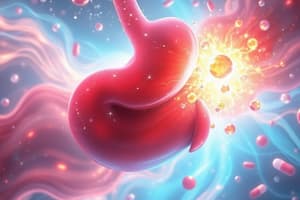Podcast
Questions and Answers
What does the GIT encompass?
What does the GIT encompass?
Mouth, pharynx, stomach, small intestine, large intestine, and anus.
What is the primary role of antacids?
What is the primary role of antacids?
To neutralize stomach acid.
Proton pump inhibitors are used for short-term treatment of gastric ulcers.
Proton pump inhibitors are used for short-term treatment of gastric ulcers.
True (A)
Which of these are commonly used antacids? (Select all that apply)
Which of these are commonly used antacids? (Select all that apply)
H2 blockers include cimetidine, nizatidine, ranitidine, and _____
H2 blockers include cimetidine, nizatidine, ranitidine, and _____
What do proton pump inhibitors block?
What do proton pump inhibitors block?
Name two adverse reactions of H2 receptor antagonists.
Name two adverse reactions of H2 receptor antagonists.
What may reduce the absorption of H2 receptor antagonists?
What may reduce the absorption of H2 receptor antagonists?
Match the following drug classes with their primary action:
Match the following drug classes with their primary action:
Flashcards are hidden until you start studying
Study Notes
Antacids
- Antacids are a class of medications that neutralize stomach acid.
- They are available over the counter (OTC) and are often used in combination with other drugs.
- Common examples include magnesium hydroxide, aluminum hydroxide, simethicone, magaldrate, calcium carbonate, and sodium bicarbonate.
Antacid Pharmacokinetics
- Antacids neutralize gastric acid.
- They are distributed throughout the gastrointestinal (GI) tract and are primarily eliminated in the feces.
Antacid Pharmacodynamics
- Antacids reduce the total amount of acid in the GI tract, giving peptic ulcers time to heal.
Antacid Pharmacotherapeutics
- Used to relieve pain and promote healing in peptic ulcer disease (PUD).
- Relieve symptoms of acid indigestion, heartburn, dyspepsia, and gastroesophageal reflux disease (GERD).
Antacid Drug Interactions
- Antacids can interfere with the absorption of oral medications if taken concurrently.
- Absorption of digoxin, iron salts, isoniazid, quinolones, and tetracyclines may be reduced if taken within two hours of antacids.
H2 Receptor Antagonists
- Commonly known as H2 blockers, they inhibit the action of histamine on parietal cells in the stomach.
- Examples include cimetidine, nizatidine, ranitidine, and famotidine.
H2 Receptor Antagonist Pharmacokinetics
- Cimetidine, nizatidine, and ranitidine are rapidly and completely absorbed from the GI tract.
- Famotidine is not completely absorbed.
- Food and antacids can reduce absorption.
- Distributed throughout the body, metabolized by the liver, and excreted in the urine.
H2 Receptor Antagonist Pharmacodynamics
- Block histamine from stimulating acid-secreting parietal cells, reducing gastric acid secretion.
- Promote healing of ulcers by eliminating their cause.
H2 Receptor Antagonist Pharmacotherapeutics
- Treatment of active duodenal ulcers or benign gastric ulcers.
- Treatment of pathologic GI hypersecretory conditions such as Zollinger-Ellison syndrome.
- Reduce gastric acid production and prevent stress ulcers in severely ill patients and those with reflux esophagitis or upper GI bleeding.
- Treatment of erosive gastroesophageal reflux.
- Relief of symptoms like heartburn, acid indigestion, and sour stomach.
H2 Receptor Antagonist Drug Interactions
- Antacids reduce the absorption of cimetidine, nizatidine, and famotidine.
- Cimetidine can increase the blood levels of oral anticoagulants, propranolol, benzodiazepines, tricyclic antidepressants (TCAs), theophylline, procainamide, quinidine, lidocaine, phenytoin, calcium channel blockers, cyclosporine, carbamazepine, and narcotic analgesics by inhibiting their metabolism in the liver.
- Cimetidine inhibits the metabolism of ethyl alcohol in the stomach, leading to higher blood alcohol levels.
H2 Receptor Antagonist Adverse Reactions
- Headache, dizziness, malaise, muscle pain, nausea, diarrhea/constipation, rashes, itching, loss of sexual desire, and impotence.
- Famotidine and nizatidine have fewer adverse reactions, with headache being the most common followed by constipation/diarrhea and rash.
Proton Pump Inhibitors
- PPIs disrupt the chemical binding in stomach cells, reducing acid production and promoting ulcer healing.
- Examples include rabeprazole, pantoprazole, omeprazole, lansoprazole, and esomeprazole.
Proton Pump Inhibitor Pharmacokinetics
- Administered orally in enteric-coated formulas to bypass the stomach due to their acid sensitivity.
- They are dissolved in the small intestine, where absorption is rapid.
- Highly protein-bound and extensively metabolized by the liver to inactive compounds, then eliminated in the urine.
Proton Pump Inhibitor Pharmacodynamics
- Block the final step in gastric acid secretion by combining with hydrogen, potassium, and adenosine triphosphate in parietal cells.
Proton Pump Inhibitor Pharmacotherapeutics
- Short-term treatment of active gastric ulcers, active duodenal ulcers, erosive esophagitis, symptomatic GERD unresponsive to other therapies, and active peptic ulcers associated with H. pylori infection (in combination with antibiotics).
- Long-term treatment of hypersecretory states like Zollinger-Ellison syndrome.
Proton Pump Inhibitor Drug Interactions
- Interfere with the metabolism of diazepam, phenytoin, and warfarin, leading to increased half-lives and elevated plasma concentrations of these drugs.
Proton Pump Inhibitor Contraindications
- Known allergy to the drug or its components.
- Caution in pregnant or lactating women.
Proton Pump Inhibitor Side Effects and Adverse Reactions
- Common CNS effects include dizziness and headache.
- GI effects include abdominal pain, diarrhea, nausea/vomiting, dry mouth, and tongue atrophy.
- Upper respiratory tract (URT) symptoms include cough and stuffy nose.
Studying That Suits You
Use AI to generate personalized quizzes and flashcards to suit your learning preferences.




